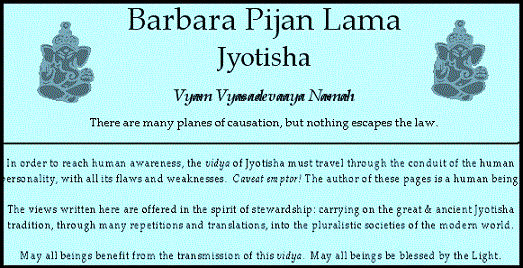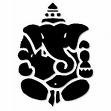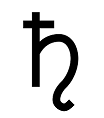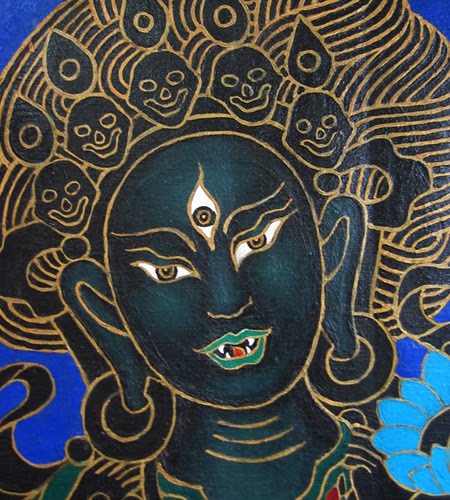

12 bhava counted from Kumbha indriya-lagna
9 graha from Kumbha indriya-lagna
Kumbha indriya-lagna
कुम्भधर kumbha-dhara = pot-holder
घट ghaṭa ghat gata = pot, jar
तोयाधार toyā-dhāra = wave-holder, water-container, river


OM sham shanaishcharaye namah
AUM eim hreem rahuve namah
OM Shri Upendraya Achyutaya Namaha
Fruits of the 12Bhava
counted from
Lagna
12 houses from the Aquarius ascendant
Kumbha = Bhava 1 - Appearances -
-
[Kumbha - Ghata] = Aquarius = principled systems
Lagnesha Shani co-ruler along with Rahu
This unlikely pair rules a svabhava of enemy Mangala.
bhava-1 signifies personal competition for social validation through a winning combination of physical behaviors and traits.
The Kumbha native seeks to develop the physical personality identity through association with science and conceptual, electronic, or social networks; marketplace connections including fundraising for progressive social causes; relationship to elders and mentors.
In particular, the Kumbha native - thought one's path may be difficult - will realize one's desires in this life, fulfilling (by peculiar or eccentric means) a remarkable range of spiritual goals.
-
The personality integrity has an inherent affinity for conceptual and theoretical science; innovative engineering development; huge social networks; large gatherings such as festivals, exempli gratia, Kumbha mela, fayres, and large-scale meetings such as political election conventions.
-
Kumbha-1 = particularly influenced by the elder sibling;
one prefers a lawful response to life.
-
Kumbha natives are generally scientific, eccentric, socially progressive folk who have a strong socio-legal interest in developing new theories and pointing out the complexity of connections between objects of material reality and objects of through.
-
The Learner may strive to maintain a competitive but regulated personality and physical appearance.
-
But even with the striving to appear regular, Rahu gives Kumbha natives a peculiar, elf-like, eccentric, even somewhat deranged appearance.
-
(IMO Kumbha natives have had elfin incarnations in their recent past.)
Appearance
Appearance depends significantly on the Shani and Rahu condition = rashi, bhava, companion planets, drishti, etc..
-
E.g., if Shani aspects the lagna, rahu's ruler owns uncomfortable bhavas, or the Shani is otherwise cramped, the Kumbha native will appear thin, wiry, and .
-
As a general rule, the Makara native is short-statured and slim. Kumbha produces a small-scale, peculiar, eccentric, or conflicted appearance.
Kumbha-born have been said to look gnome-like. May display attributes of gnarly, sinewy, compressed, or shrunken about the overall physique.
Dhaniṣṭha indriya-lagna or Dhaniṣṭha-Chandra can be associated with crazed eating behaviors and marvelous dancing abilities (Kumbha = drums and pulsing beats).
Due to the Shani-Rahu combat they are quirky and scientific and can make sudden, terrible, or brilliant moves.
Tendency to manifest the Rahu element of Kumbhu which gives exotic scientific knowledge, often far ahead of its time.
the Learner is juggling Shani's signal to conform and reduce one's size in order to be more efficient, versus Rahu's desire to quest for new experiences and enjoy the thrill of risk. The Learner may be perceived as crazy or highly polarized in personality.
the Learner is aware of interspecies connections and if too much vocal about this awareness may find oneself ostracized. In general the Kumbha native needs to be moving constantly in order to prevent Rahu, shani, and Mangala from going to war inside the personality. If lagna = Dhaniṣṭha Nakshatra, the Kumbha native may be an excellent dancer .
Zatabhishaka lagna has a tendency toward chronic depression which can be alleviated through movement. The appearance changes over time, sometimes dramatically.
When Shani dominates in the Vimshottari Dasha or by result of a strong transit, the Learner looks and acts quite conventional, even staunchly conservative. However, when Rahu dominates, the Learner may take enormous risks to address a driving passion. The Learner may even"hear voices "at times when the conflict between Shani and Risk-rewarding Rahu reaches a peak.
Rahu tends to destroy Shani's physical stability, and find that one's inner direction creates health problems (due to Chandra rogesha-6 ) plague Kumbha-lagna folk may have a vata or slightly blue-colored cast to their complexion, avery slightly opaque bone-colored patina, relative to their gene pool. (Moon's sign and characteristics also influence appearance.) Kumbha's intuition comes from Shani = ruler-of-12 and also lagnesha-1 .
Kumbha is a common birth lagna among gifted psychics. Typically, the Learner is hardworking, but one has a universalist viewpoint that promotes personal work as a vehicle for social change.
Kumbha's perceptions focus on large-scale patterns of human reality. Natural scientists, but may not be able to articulate their findings due the eccentric nature of the methods employed. Can be spacey and abstract.
Bhava 2 - Meena - Antya = Pisces
Values, Knowledge, Languages, collections, wealth, acquisition, accrual, banking, archives, storage, archives, hoards, History, face, speech, song
Graha in Bhava-2 expression prize = price = appreciation = preciousness or changes to the appreciativeness of the family (2) toward the Learner . The type of appreciation is determined by the character of the grahar.
Graha in Bhava-2 expression prize = price = appreciation = preciousness or changes to the appreciativeness of the family (2) toward the Learner . The type of appreciation is determined by the character of the graha.
[Generous Growing Guru] governs a svabhava of enemy Shukra.
Despite auspicious implication for expansion-karaka Guru ruling the cintamani = mani = money and values Bhava, Guru's animosity toward Shukra's sensuality creates conflict in this Bhava.
For Kumbha indriya-lagna , presuming that Guru is fairly well disposed, periods of dhanapati-2+Vriddhi-pati-11 Guru generate considerable wealth via family-of-origin hoarded assets and knowledge-values, as well as via earned income from the marketplace of goods and services.
Values are broadly compassionate, with special concern for welfare of children and the disenfranchised. Depending on condition of Guru in D-1/D-9, they have extremely charitable views that cause them to give away their own wealth to those in need - thus plunging the Learner into need themselves!
Not overly identified with their personal birth families, due to their cosmic perspective which places them more in the human family. Often remain childlike, always dependent, unable to acquire the full means of their own support (unless Shani is quite strong or Moon is independent). The second marriage may be very supportive Yet, accommodating the free spirit, if Guru is comfortably placed.
Kumbha indriya-lagna = generally a fortunate birth due to Budha, Guru, Shukra , shani, and Rahu playing socially and materially supportive roles. Even Kuja is helpful for career. The one drawback of Kumbha is However, the parents. The mother in particular is often ill or disagreeable, and when Chandra occupies 2 the family lineage reflects the mother's discontent.
= the family is charismatic, political, and theatrical with characteristically bright faces. Their style of showing appreciation to the Learner depends upon the treasury that one brings into the family coffers.
The father is primarily concerned with maintaining the financial well being of the lineage. Father may be involved in banking, archives, storage, collections, conservation, value, traditional knowledge, genetic breeding, historical records. Patriarchal figures are prone toward self-righteousness and usually the father is the solar center of the lineage.
Surya occupies Meena imaginative visions = ruler of 7 occupies 2
= the family is sensitive and routinized in their style of showing appreciation to the Learner . Mother may be primarily concerned with maintaining the financial well being of the lineage. She can be involved with banking, archives, storage, collections, conservation, value, genetic breeding, lineage knowledge, historical records. Mother is often the center of this lineage which features pale, gently radiant moonglow faces.
Family heritage = deeply identified with the Old Ways (Soma) but feels a need to revision the values of the traditional folkways.
= the family is competitive and outspoken in their style of showing appreciation to the Learner . Brothers are dominating and vigorous. Often an athletic or warrior lineage. the Learner and the brothers are concerned with financial well-being, which is typically present at birth and energetically pursued by the Learner .
The family may be dynamically successful in their pursuit of material treasures, particularly conserving wealth derived from Mangala acts such as military invasion, forceful explorations, weaponry, engineering, surgical tools, driving, diving, drilling, plumbing, plowing, hunting, excavating, explosives.
[Mangala-Meena ] = ruler of 3-10 resides in 2
= the family is communicative and gesturing in their style of showing appreciation to the Learner . Younger siblings of either gender may be managers of the financial well being of the lineage. Siblings and cohort-members can be involved with banking, archives, storage, collections, conservation, value, genetic breeding, lineage knowledge, historical records. Siblings are often active in the center of the family lineage.
Lineage expression tends to be highly conceptual, visionary, and poetic but may suffer from woolly thinking.
[Budha-Meena ] = [nīcha] = ruler of 5-8 resides in 2
= the family is expansive and inclusive in their style of showing appreciation to the Learner .
In the nativity of a wifely-companion, her husband, represented by dhava-karaka Guru, is a curator of the marriage finances.
For a husbandly Learner, one's financial holdings are influenced by the paradigm of belief. One's own knowledge of values and history is expanded by the presence of teacher-preachers in the family lineage. Sacred doctrine may play a central role in the family tradition.
[Guru-Meena ] ruler of 11-2 resides in 2 = dhanayoga
= the family is balanced, aesthetic, and aligned to financial well-being in their style of showing appreciation to the Learner . In the nativity of a husbandly Learner , Shukra indicates the wife. For either husband or wife, Shukra indicates sister, sisters-in-law, aunts, and feminine associatesare lovers of luxury and beautiful in an other-worldly way. the Learner often has a charismatically attractive voice.
The sisterly-ones are concerned with financial well-being, which is typically present at birth and improved by the contractual, agreement-making abilities of the family's women and the Learner .
This is perhaps the most superlative position for Shukra. It brings exceptionally beautiful and gifted Feminine Nativities into the life, along with financial well-being via the mouth, voice, eyes, speech, languages, knowledge of history, visual arts and music.
[Shukra-Meena ] [uchcha] = ruler of 5-10 resides in 2
-
A New Earth 1948- philosopher Eckhart Tolle
= the family is delayed or stalled in their style of showing appreciation to the Learner , but in time the necessary spiritual clarity will arrive. Shani is comfortable in Meena , aneutral rashi. Shanicarya casts drishti into 4-8-11 straitening conditions in the childhood home, imposing strictures in the foundational education, limiting the inheritance, and slowing the pace of economic gains. The material treasuries are slowly and dependably gained via visions and guidance from the ancestors.
The family carries a weight of perceptual limitation due to materialism and emotional handicap, preventing it from appreciating its own lineage. Agents of the government, officers of the social order, the elderly, hierarchs, and other Shani-figures may limit and restrain the family's acquisitions.
Shani produces heavy restraint and social obligations upon the lineage, constraining but not denying wealth acquired via divination and astral bridging. Family is often involved in the social governance traditions.
[Shani in bhava-2] Steady time-structured values-fulfillment = scarcity of precious resources = must preserve historic traditions = must gather = must catalog = obstructionist family-of-origin = must remember = cautious use of words = boney face = tense eyes = class-conscious speech = speakers' fatigue = chronic financial insufficiency = undernourished eye-teeth = must use old libraries = cold dried food hoard = limited sight = ossified heritage = language regulator = appreciates ignorance = maintains treasuries of proven knowledge = hierarchies impose know-nothing rules = elders hold center of family
[Shani-Meena ] = ruler of 12-1 resides in 2
-
de Mundi Systemate 1643-1727 Isaac Newton [Shani-yuti-Ketu] Shani-2 parivartamsha Guru-1
= The family is ambitious and seeking social mobility. Often the lineage is irregular in some fashion; most Typically, an imposter from another line is claiming legitimacy in the family line (usually a case of disguised parentage. Rahu's angle from Chandra will reveal this impostor.). Rahu-2 indicates a craving to expediently obtain the privileges accorded to the class of bankers, hoarders, treasurers, and preservers.
May an obsessive collector of dreamlike things, and use this collection as a platform for social ascendance. Meena favors guidance from Other Worlds; the family's response to the Learner is often deceptively dreamlike.
If the family finds it expedient to promote and appreciate the Learner , this may occur. Yet, if the family finds it expedient to disgrace the Learner , this may also occur. Find Rahu's ruler Guru, and evaluate other graha in 2, to determine which path is most instrumental for shape-shifting Rahu.
Lineage features individual or family over-reaching [Rahu] via prayer, dreams, meditation, spiritual guidance, clairsentience and claircognizance, and private enclosures.
[Rahu-Meena ]
-
300 Combinations 1912-1998 Jyotiṣika B.V. Raman
= the family may be disinterested, dispersed, or disregarding in their style of showing appreciation to the Learner .
The family's lineage treasury may dissipate over the period of one's lifetime. Second marriage is rare with Ketu-2, and if it occurs the spouse is eccentrically detached from oneself. Find Ketu's ruler Guru, and evaluate other graha in bhava-2, to determine which outcomes are likeliest.
[Ketu-Meena ]
-
de Mundi Systemate 1643-1727 Isaac Newton [Shani-yuti-Ketu]
Sahaja Bhava 3 - Mesha - Aja = Aries
Mental Process, naarrative, communications, writing, publications, business administration, commerce, siblings, teamwork, conversational interaction
[Competitive Champion Kuja]governs a svabhava
[svabhava] of Budha Mental health is volatile with warrior Mars at the helm. Innovation, ingenuity, and impatience. Kumbha natives endure a prolonged adolescence, reaching well into adulthood. Mangala keeps the Learner scheming about new ideas and new plans for their worldly success.
When favorably placed+ bhratru-pati-3 Mars gives success in new ideas business such as sales, marketing, product development, advertising etc. When Mars is not dignified, amillion new ideas burst into flame and die because Kumbha indriya-lagna lacks the egoic-mind membrane drive to push concepts to completion. Thinking process is positive but impatient for results.
Works best in a team that can assume detailed follow-through after Kumbhadhara has birthed the cosmic concept. Likes to talk, but may not be able to explain where their ideas come from. Extremely independent-minded.
Likes to socialize around the theme of physical prowess, such as body-shaping exercise, athletic dance, hairstyling and beauty culture, individual sports that focus on personal speed or musculature. self-made treasuries (when available) via making development plans for individuals to change their minds and/or bodies, or to achieve more independent lifestyles.
Bhava 4 = Home, family, security
non-moveable wealth
[Vrishabha - Urisha] = Taurus
-
needs luxurious home properties
-
ideally near the splendidly green fields and forests
-
Security is almost completely defined by material money-bank and property
-
may practice cattle-related and banking or collecting activities in the home
-
pleasant feminine influences in the home and homeland
Vrishabha = emotional (Chandra's Bhava) need to establish security via acquisition of lands, homes, warehouses, ships and shipping ports, transportation and vehicles.
-
Whether masculine or feminine-identified, one takes the conservator-collector role at home.
For Kumbha indriya-lagna , bhava-4 = ruled by Shukra = Enemy of Chandra; therefore, some complication along the path to achieving the deepest physical and emotional security in life.
-
Chandra-yuti-Shukra = "spoiled" patterns of emotionally triggered sensual indulgence.
Problems in the childhood home or with the parents are often related to ostentatious materialism of the parents which results in exaggerated luxury entitlements in the child they have raised.
Home, shelters, boundaried Lands, and Vehicles Ownership
Although general a positive placement for sensual happiness via ownership of non-moveable wealth (shelters and lands) + moveable shelters (vehicles), some combinations spell loss.
-
Common patterns of property loss through "champagne taste on a beer budget" Shukra occupies 12th-from-4-stability (3); Shukra = nichha
[Kanya]; or Shukra suffers moudhya-dosha
Parents = sweets
The parents are property-owners Lands-management or deeds of title to various buildings is a core feature of their social identity.
the Learner feels sentimental affection for the parents even if the caretakers have harmed them. This is a sweet position for relationship to the parents and home culture under almost all circumstances, except when Shukra = nīcha-amsha.
-
If Shukra is strong, parents may hold numerous properties and vehicles. One's sense of normalcy is based on sheltered, non-moveable wealth of buildings and vehicles.
-
However proportional to the size of the holdings, one must manage a large herd or many fields or a large Bhava with occupants. Shukra must be not combust and Chandra should be emotionally stable showing dedication to shelters in order for this venture to succeed.
-
If Shukra is awry, tendency toward ostentatious or flamboyant pseudo-luxurious decor.
-
Can be a compulsive collector of expensive vehicles if Rahu or other twist
The Learner may need to collect cintamani = mani = money (Vrishabha) for an extended period of time to securely purchase one's ultimate grand property. Also favors the ownership of rental properties. .
Shukra-4 Malavya Yoga or Chandra-[uchcha] 4 favors the acquisition of luxurious estates, palatial homes, and highly expensive vehicles.
If rental properties are owned, tenants should be feminine-figures such as school-teachers, mothers, and other pleasant ladies.
Sweetness in the roots of home and homeland. Depending on Shukra's condition, tend to have tastefully decorated homes where they enjoy nice dinners. Like to share their extended family feeling of abundance and luxury, inviting neighbors and colleagues into their lush homes.
Quality and location of home is very important; ideally it should have a natural setting in field or forest, and home design reflecting the natural environment., comfort and luxurious furnishings are hallmarks of their home style.
Characteristics of Shukra will determine how this aesthetic is expressed. E.g., if Shukra occupied Kumbha the home decor will be quite eccentric or even 2nd-hand-chic, but if Shukra is in Vrishabha the home will be comfortable, cushioned, and traditional .
Bhava 5 = children, creative intelligence, genius, politics, theatre, games, performance arts
[Mithuna-Dvamdva] = Gemini
Budha activates svabhava of Surya
Self-expression channels naturally along literary lines.
-
If Budha is well supported, the Learner may be an excellent writer of narrative script -- exempli gratia, film script, novels, any type of documentation or story-telling.
Children are intelligent and talkative. If Budha is well disposed, success in political campaigns, speculation and prediction, theatrical performance, promotion of creative literary works, sports coaching. Likes literature and authorship, languages and talk about languages, political discussions, current events, and the company of articulate people.
Bhava 6 - Karkata - Kadaga = Cancer
Chandra activates svabhava of Chandra's adversary Budha
6th-from- kumbha - 6th-from-Chandra -Kumbha
Sympathetic, nourishing, sheltering Chandra activates bhava-6; therefore, Kumbha is fundamentally conflict- oriented and loyal to the problematic home environment.
Dedicated to the ill parents (especially the ailing and conflicted mother); the distrust, divorce, disagreement, accusations, blaming or crime in the home culture; also, protective of the physicians, druggists, exploiters and exploited, the servants, the military, the addicts and the diseased.
Service Professions
May defend and protect [Chandra] any ill, exploited or addicted person, even a criminal person-corporation-government that has harmed others.
When Budha is well placed for professional verbosity, Kumbha-born may enjoy serving as public defender attorneys who argue for the protection of accused mis-doers.
If Chandra is afflicted, emotionally based self-medication issues may arise.
If the nativity indicates sufficient professionalization, the Learner may realize great success for in physical medicine, particularly in vast-scale or mass-treatment situations such as public health and scientific epidemiology.
Kumbha birth assists those who work sympathetically with the victim class.
Within a Kumbha nativity, all varieties of Chandra-confifuration can successfully minister to the marginalized and hurting. For best results, the injuries and diseases of the victims should match the qualities of one's own Chandra.
Health balance tends to fluctuate
-
Karkata represents the fluctuating fluids of oceans waters seas -- all liquids, both internal and external.
-
Naturally, whichever bhava is ruled by Chandra, will fluctuate in tides and flows
-
Rulers of 6-8-12 from Chandra-lagna may indicate a learning-curriculum plan for emotionally provoked illness [6] sudden shock or upheaval [8] or identity loss [12]
-
Unless Chandra is located in a socially conservative rashi, and in Kendra, the Kumbha native may experience learning-challenge finding the emotional steadiness necessary to maintain long-term commitments such as marriage vow.
Debt and illness cycles fluctuate significantly, depending on the mood of the Earthen-Moon. Watch the Vimshottari periods of Soma for ebb and flow of the Ocean-tides of internal argumentation.
If Chandra is compromised, there can be noticeable physical-health effects due to emotional holding of past resentment., Effects may be particularly evident around the 4th chakra in the lunar-zone areas of breast, chest, heart, lymph.
Mother
Kumbha-born tend to have formed pre-incarnational contracts with mothers who engage in exploitive service work, or are victims of severe debt or social conflict (even war), or struggling with health problems, or in a state of marital disagreement.
The most likely situation = the Kumbha-born has a mother who accepts a state of chronic dissatisfaction in her marriage by internalizing her grievances.
Chandra = pre-verbal
The Kumbha-born child may intuitively absorb the mother's chronic -- but typically non-verbal -- argumentation. Kumbha may experience learning-curriculum crafted obstacles within emotional relationships throughout life. Chandra rogesha supplies an implicit expectation that emotional security must be purchased at the cost of imbalanced conditions, such as exploitation or poorhealth.
Soothing pulse of Emotional conflict with Protectors
Depending on the detailed qualities of Calming Chandra , the Learner may have a surprisingly deep emotional attachment to one's own enemies.
It is especially challenging for the Kumbh-born to self-liberate from the familiar rhythms of adversarial protective relationships.
Due to rogesha Soma, a state of mutual disaffection is emotionally comforting. traceable to the pre-natal state of mind.
If the ruler of the paradigm of belief joins dharmesha Shukra, is favorable, a Kumbha native may believe (mentally) in the power and reality of forgiveness.
Yet, the Learner may continue to hold a grudge due to the ironically comforting effects of constant disagreement with those who provide one with a sense of security and belonging.
Kumbha-born may feel an instinctive pull toward challenging human service positions, because the Learner feels most at-home when serving those whose lives are defined by cycles of physical, emotional, or social suffering [6].
Naturally, it is a marvelous placement for those working in geriatric medicine, or other ministries of service in which palliative treatment is offered, rather than resolution or cure.
Usually they care deeply about health of self and others, even while continuing to practice repetitive emotional behaviors that perpetuate toxic imbalances.
Potential for enlightening upliftment during Chandra bhukti
Vimshottari bhukti of the rogesha are extra-demanding for everyone. Yet for Kumbha-born, Soma periods also signal an intensification of their deepest sympathies toward those who are living the script of the victim-narrative.
With sufficient insight, Chandra bhukti intervals can elevate this inherent sensitivity toward sufferers of human misery into genuine compassion.

Bhava 7 - Simha - Leya = Leo and 7th navamsha
Surya activates svabhava of enemy Shukra
Surya vs Shani-yuti-Rahu
-
Kumbha "Hridroga" = enemy of the heart
-
Professor Shani and Professor Rahu , the co-rulers of Kumbha, are both bitter enemies of Professor Surya who is the planetary patron of the realm of Simha.
Kumbha = in many ways the single most difficult lagna for purpose of satisfaction within relationships, whether business partnership or marriage.
egoic-mind Centrality Entitlement
The best partnering style = Shukra = balanced, equable, committed to maintaining equity of investment and returns, agreeable, other-oriented, paired, two-parts
-
If Surya the brilliant and confident karaka of Truth should become compromised by unfortunate association, the Learner may develop a self-righteous (Ravi) style of conduct in alliances that is self-focused, opportunistic, intolerant, and politicized rather than equitable and balanced.
-
If such a Surya disability develops, it may manifest in a partnership culture of exaggerated entitlement, in which the only acceptable behavior of spouse and partner, both personal and professional, is that which directs praise and applause upon the center-stage native.
-
The creativity of the partner may be stifled by a dominating, attention-hungry Kumbha native, who wishes the public to see one as the 'Brilliant' Partner.
Kumbha can "act out" via applause-seeking in the first marriage. Yet, ravi rules only one bhava, therefore (usually) most of drama is contained within the first marriage. The second marriage may be easier. End of drama is helped if no graha yuti Surya or if beneficial graha in bhava-2 .
Surya vs Shukra
Due to the adversarial relationship between Shukra, the natural regulator of alliance and unions, with Surya, the natural regulator of center-stage genius and the divine ideal, partnership for Kumbha indriya-lagna is fraught with internal inconsistency of expectation and outcome.
The single leading cause of unhappiness in the Kumbha partnership behavior is a theatrical tendency to idealize the basic animal mating-collecting behaviors, idolize a perfectionist concept of marriage and deify the human partner.
-
As a result of becoming quickly enamored with the "star qualities " of the Other, the Learner tends to rush into marital commitment, blinded by the light of the partner's apparent charisma, only to find out rather quickly that the partner is indeed merely human.
Kumbha = overall seeking to partner with a kingly-queenly type of personality: one who enjoys attention, can control a room, is confident, intelligent, beautifully appointed in ornament and dress, and seems to bring the Light of divine beauty wherever this splendid person goes.
-
Yet, as soon as the normal range of human flaws in spousal behavior begin to emerge over the course of Time, Kumbha begins to lose interest.
-
Often, atragic pattern of quick marriages or hot-Bhava romances ending in cancelled engagements will dog the Kumbha native throughout life.
-
If Surya is disadvantaged by rashi or drishti, amuch-married individual is Kumbha.
Kumbha as planetary patron of navamsha is particularly troublesome unless some pragmatic force such as Shani in Kumbha corrects the idealization error . Shukra-Kumbha can have some similar results.
Kumbha is Surya the Self rules the Bhava of His bitter enemy Shukra the Partnership.
Marriage = conflicted
-
when the partner's need for immediate recognition and praise = not being met by the abstract-thinking, future-oriented Kumbha native .
Kumbha is attracted to partners with strong, center-stage, egoic-mind driven personalities. Kumbha natives project attributes upon life partner which are highly idealized, golden and radiant, near ly godliker.
Particularly when Simha rules the 7th navamsha, the mate shows brilliant, amusing, entertaining intelligence. One who Naturally, takes the center position in any group, radiating light and divine genius to everyone in their court. The Kumbha suitor is a member of this courtly audience; one admirer among many.
Kumbha's broad, morally neutral, complex-systems worldview does not readily admit a"central" position because Kumbha operates in the framework of distributed systems. Yet, as difficult as the axis of Kumbha-Surya can be, Kumbha does have a psychological predisposition to find a partner who is in some fashion the charismatic Center of a web that has no center.
If Surya is well disposed in the Kumbha-lagna Learner , the Learner will marry a confident, self-possessed, noble partner. This partner requires admiration and applause; and opportunity to express the natural genius in some literary, theatrical, or political setting. Generally, it is a bit easier when the person with Simha on 7th navamsha is female with a male partner, since Surya indicates a male
Kumbha functions a bit like a stage-manager for the partner, managing the partner's affairs in a dutiful [Shani] background style,and basking in the light of the spouse's theatrical, literary, or political talent.
If Surya is poorly placed, the spouse can become an egomaniac, demanding constant attention and presuming that the marriage partner orbits around their royal self. This dilemma is not a problem with domination but rather a politicizing of the issues in the marriage and a self-centered "acting out" which over-emphasizes the natural theatrical talents of Simha.
Under stress, the Kumbha native tends to distance oneself, retreating into work, the company of friends or large-scale social change projects. A Kumbha male in particular will retreat into goal-oriented gainfulness, removing oneself from competition for time in spotlight; Kumbha can easily focus upon long-term goals and earnings with no need to receive personal attention.
The downside of this arrangement
can develop when stress forces Surya's characteristics to take their negative expression. Self-possession can deteriorate, under duress, into self-centeredness. After a courtship noble and intelligent, as Kumbha retreats into the natural spacey, friendly, networking and group-oriented social behaviors, while the attention-deprived spouse may become flamboyant and demanding, or sulking and withdrawn in a ploy for dramatic sympathy. Should the Surya partner perceive a threat to their center-stage entitlement, aroyal rage for attention may ensue.
The relationship can become inflexible due to the polarization of Kumbha's understanding of the world, which is distinctively hard-working, neutral , future-oriented and scientific; versus the Sun's desire for personal, creative, opinionated, immediate centrality.
There are many exceptions
to the negative forecast, particularly when the two lunar Nakshatra are well matched and the radix Chandra of partner-A occupies the navamsha of partner-B and vice versa. These stronger unions will weather most of the polarizing effects by jointly working in community service and periodic holiday outings into strong sunlight.
The main indicator of success and indeed of the personality of the intimate partner (sexually intimate or financially intimate as a business partner) will be the disposition of Ravi in the radix and any graha in bhava-7 .
All intimate partnerships are psychic mirrors. Not only sexual unions, but also business unions where two partners deeply share a vision, and resources. Certain parts of ourselves, such as compulsive behaviors and unrecognized beliefs, can only be seen in the mirror of the partner.
Kumbha tends to engage intensively with others who promote themselves as worldly, capable, confident, and possessed of considerable resource. The more Surya influences yuvati bhava (in D-1 or D-9) the more deceptive this exaggeration of personal power can get. If Surya is also rising and thus casting drishti upon kalatra bhava, the partner's bravado might range from dramatic bragging to outright criminal deception.
However, normally there is simply an excess of dramatic energy in Kumbha's 7th Bhava, alocale which requires less egoic-mind membrane and more concern with the interests of the other in order to be a happy place.
Partnerships are founded on shared ideals and a vision for the future, rather than measurable emotional harmony or joint family responsibilities. One embarks into the duties of marriage on a istinctively idealistic basis.
Thus, Kumbha's partners, unless they are super-intellectual visionaries and truly capable in the world, are likely bore the Learner - who rather quickly moves on.
Contracts, agreements, legal discussions, all types of advising are typically distasteful to Kumbha, who prefers to have the partner manage their worldly affairs. Divorce is common, because of Kumbha's rational response to conflict.
Spouse can be made into a workhorse, piled up with duties and schedules, treated as a fixture in public life, emotionally ignored. Intimacy problems. Does better with an older or more conservative spouse whose self-image is also invested in public role-playing.
~~ Bhrigu Sutram Sarga-34 Shloka-12
"If the sign Leo or the Sun's Navamsha be descending,
the husband will be very mild and will do various works (some take it: - will indulge in much sexual union)."
"If at woman's birth, the 7th bhava or the setting Navamsha be that of Simha,
her husband will be exceedingly soft in his disposition and will be very hard working."
Bhava 8 - Kanya - Parthya = Virgo
Budha activates svabhava of Kuja

Joint assets of marriage are modest, depending always on fluctuations of Budha. The life-partner may be helpful in promoting public identity (8th Bhava is 11th-from-10th, spouse's contribution to joint assets is normally gainful for career.)
Whatever wealth Kumbha may possess comes from mental, verbal work such as counting, thinking, writing, selling etc. The spouse is normally from a family of equal social standing to the Learner , relative to their birth cultures.
Normally it is easy for Ghata-lagna to access deep healing modalities such as psychotherapy, therapeutic massage, and other regenerative modes. Kumbha folk latch onto therapeutic concepts quickly, and immerse themselves into the narrative of healing without resistance.
Shukra activates svabhava of Guru.
World travel
-
Temples of wisdom,
-
preachers, pontiffs, and professors,
-
father-figures, dogma and doctrine,
-
children and grandchildren
-
mountaintop celebration of Divine Light
Principles of Philosophical understanding;
the Temple;
High-Priesthood; pontiff, proselyte
Guru; Professor; University;
Wisdom Wit Knowings;
Father-figure; Pitri, patrons, patronage;
doctrinal instruction and paradigm of belief
human perception of Divine Law
The inspiration and consolation of Religion is easily accessible to Hridroga-lagna. As always, if Shukra is compromised , there may be less happiness in the dharma.
An easy faith arises in their lives, due partly to their love of religious art forms and intellectual attachment to the concept of harmony. They enjoy the company of religious teachers and appreciate the fellowship of their sangha.
A feminine quality is present in their teachers and religious traditions, often centered on a female deity - or, more abstractly, on the intentional balance of yin and yang energies.
The father's character depends on Shukra's condition, as well as whatever is happening in 9th-from-Moon. However, in general, the father and guru live balanced lives.
Some tendency for father and guru-figure to have multiple marriages and families - sometimes simultaneously - especially when Shukra occupies a dry, impersonal sign like Kumbha, Kanya, or Makara.
Bhava 10 - Vṛścika - Thriketta = Scorpionis
Kuja activates Vṛścika, while bhava-10 = the svabhava of lagnesha Shani.
Kumbha Leads and Governs: knowledge-collection and wealth-banking (Vrishabha)
Kumbha = leaders (10th-from) of knowledge-collection and wealth-banking (Urisha)
Kumbha folk are characteristically very alert to the role and importance of treasuries -hoard in the society. Although their style = distributive and due to Rahu's involvement also barrier-bending, taboo-twisting , so that Kumbha-haru cannot continue the lineage-channeled asset accumulations of Vrishabha, Kumbha can impose a materialistic filter that is committed to alteration, expansion, and adaptation of the asset -collection systems , not destruction of them.
-
Das Kapital 1818-1883 economics Karl Marx , the famous political philosopher of communist social systems = Kumbha indriya-lagna containing a dramatically empowered svakshetra Shani
With Kuja as the 10th lord, Hridroga-lagna has plenty of energy to invest in career development. Not only is the egoic-mind membrane (yuvati-pati-7 Surya) generally wanting to promote the concepts of balance and partnership in society, but also their deep need to express themselves through grand social visions, motivates Kumbha indriya-lagna to put much energy into doing something on the world stage.
As always, for their world vision to manifest, Kuja must be empowered via Bhava and Rashi . Hridroga has plenty of physical energy for public works, but the gap between conception and execution may be caused by investing too much of their life force in the partner's view.
Tempting as it always is to promote their partner's cause (, to hide their egoic-mind membrane behind the image of their partner), Kumbha indriya-lagna benefits to acknowledge their own egoic-mind membrane and their own ideas.
Brainstorming their ideas with groups of multi-talented friends, they can capture the prey of worldly success in a team effort with those who share their universal healing vision.
Bhava 11 - Dhanus - Haya = Sagittarius
Guru activates svabhava of lagnesha Shani
Generous Guru activates Kumbha-lagna's 11th Bhava of friendships and marketplace associations. Hridroga folk truly enjoy socializing. They have expansive networks of family and friends.
Because Guru activates bhava-11 of income and also bhava-2 of stored wealth (savings, hoards, historical records, food pantries, etc.) - Guru's condition will accurately predict their asset accumulation levels.
Guru's natural compassion and open-mindedness brings Kumbha-lagna into the company of humanistic, optimistic, good-humored folk. Unless Guru is fallen in Makara (which cramps optimism) they enjoy great abundance of friendship, they are rarely short of cintamani = mani = money. Periods of Guru can bring considerable wealth.
For Kumbha indriya-lagna , presuming that Guru is fairly well disposed, periods of dhanapati-2+Vriddhi-pati-11 Guru generate considerable wealth via family-of-origin hoarded assets and knowledge-values, as well as via earned income from the marketplace of goods and services.
Friendship Networks Guru as Vriddhi-pati-11 favors friendships with teachers, both secular and religious. Happily, the Learner counts many religious persons, philosophers and priests within one' social network.
Most likely friends are teachers and the philosophically inclined.
if rogesha-6 in 11:
Presence of rogesha-6 Chandra in 11 can indicate one who becomes depressed and frustrated with the emotional behaviors of unfaithful friends.
Bhava 12 - Makara - Draco = Capricorn
Shani activates svabhava of neutral [Generous Growing Guru] .
Kumbha = disconnected (12th-from) spiritual guidance and reflective intuition;
The meditation and inner sanctuary Bhava is somewhat repressed by Shani's relentless demand for duty and responsibility. Unless Shani occupies vyaya bhava or there is some favorable setup , Kumbha folk may never relax enough to meditate or pray.
Vyaya bhava is also the Bhava of bed pleasures and other private imaginative enclosures. Their bed pleasures and holiday getaways might become overly routinized, expressing their sense of order, efficiency, economy, and duty.
Body-calming, spa-type deep relaxation are generally too time-wasting. Rather, Kumbha-lagna prefer to relax in the dignity of well-earned sleep, after a productive day of socially approved labors.
Unless strong planets occupy vyayasthāna, Kumbha-lagna resists foreign travel. Kumbha-lagna do not enjoy being away from familiar rules, folk customs and established cultural norms. Should a Shani bhukti enforce extended residence in a foreign land, Kumbha-lagna will endure the discomfort - particularly if such tenure promotes their career.
One exception to Kumbha-lagna's dislike is that they enjoy cultural and religious ceremonies. If you are hosting one of these folks, take them around to public events! Kumbha natives are happiest at work, surrounded by familiar imagery, living and thinking according to the Old Rules.


[How Readings Work] = [Sample Sacred Jewels Ratna Recommendation] = [Seva]
 file update =
19-Jan-2026
file update =
19-Jan-2026
[Copyright © 1994-2024 by Barbara Pijan Lama] = [Contact] = [How to Request a Jyotishavidya Reading]
Barbara Pijan Lama Jyotishavidya Vedic Astrology Surya Sun Chandra Moon Mangala Mars Budha Mercury Guru Jupiter Shukra Venus Shani Saturn Rahu Ketu Graha Planets Dasha Timeline Calendar Nakshatra Navamsha Marriage Children Treasury Career Spiritual Wisdom Cycles of re-Death and re-Birth
The information on barbarapijan.com , including all readings and reports, is provided for educational purposes only. Wishing you every happiness and continuing success in studies!